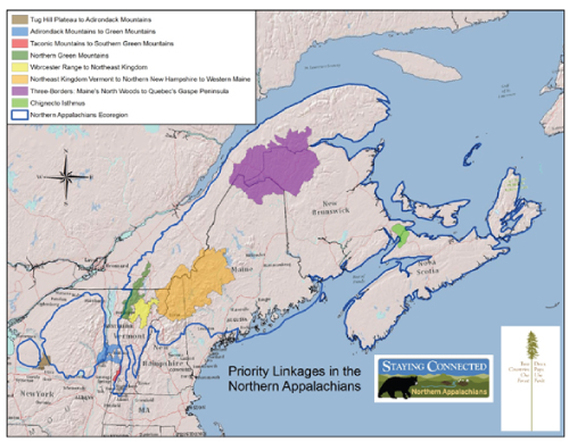2014 CONFERENCE: Field Trip
Tuesday, September 23 / 1:00pm - 5:00pm
For the first time, this year’s NETWC will feature a half day field trip for all conference participants. The Staying Connected Initiative (see below) is hosting the field trip and will be taking participants to three sites in the Champlain Valley and Green Mountains of Vermont to highlight various aspects of habitat connectivity. While the sites are Vermont specific, field trip leaders include both local and regional experts such that we can use the local context as a springboard for discussion of how these concepts play out across the NETWC region. Field trip stops will highlight conservation science that is the first step in this work, including both connectivity modeling based on land use/land cover and transportation corridor data and site-specific field monitoring. We’ll look at specific transportation infrastructure designed to pass wildlife safely, and explore land protection and land use planning as key complementary strategies to address habitat connectivity beyond the right-of-way. Together these stops offer participants a robust understanding of the challenges, opportunities, and partnerships involved in the full suite of strategies related to habitat connectivity work in the northeastern US and southeastern Canada.
This field trip will be held rain or shine; please pack accordingly.
Itinerary
• Little River Bridges, Route 2 / I89, Waterbury, VT. – At this site we’ll discuss the region-wide GIS modeling of habitat connectivity, use of game cameras for wildlife monitoring, and look at an engineered wildlife shelf associated with three large bridges over the Little River.
Presenters: Dirk Bryant, Director of Conservation Programs with the Adirondack Chapter (New York) of The Nature Conservancy. James Brady, Environmental Specialist with the Vermont Agency of Transportation. Paul Marangelo, Senior Conservation Ecologist with the Vermont Chapter of The Nature Conservancy.
• Shutesville Hill, Route 100, Stowe, VT. – At this site we’ll explore a critically important wildlife road crossing and discuss the use of land protection (conservation easements and fee acquisition) as a tool in maintaining connectivity beyond the transportation right-of-way as well as the efforts of local conservation commissions in promoting the importance of this site and in implementation of connectivity-related work.
Presenters: Kate Wanner, Project Manager with the Trust for Public Land, Northeast Office. Louise Gratton, Board Chair of Two Countries, One Forest, Quebec, Canada. Allan Thompson, Forester for Northern Stewards and member of Town of Waterbury Conservation Commission.
• VYCC Monitor Barn, Route 2 Richmond, VT. – At this site we’ll discuss technical assistance efforts by Staying Connected Initiative partners with the Town of Bolton Planning Commission as they work on town land-use planning to address habitat connectivity and forest fragmentation. We’ll discuss municipal planning in Vermont and the broader region and explore how tools like town plans, zoning ordinances, and subdivision regulations can be used to affect habitat connectivity at the local level.
Presenters: Jamey Fidel, General Counsel/Forest and Wildlife Program Director at Vermont Natural Resources Council. Michale Glennon, Science Coordinator for the Adirondack Program for Wildlife Conservation Society.
Trip Leaders; Jens Hawkins-Hilke, Conservation Planning Biologist for Vermont Fish & Wildlife Department. Phil Huffman, Director of Landscape Conservation and Policy with the Vermont Chapter of The Nature Conservancy. Chris Hilke, Program Manager of the Climate Adaptation Program for the National Wildlife Federation.
What is the Staying Connected Initiative?
The Staying Connected Initiative (SCI) is a large landscape conservation partnership focused on conserving habitat connectivity across the Northern Appalachian/Acadian Ecoregion. SCI aims to safeguard wide-ranging and forest-dwelling wildlife, such as bear, moose, lynx, marten and bobcat, from the impacts of habitat fragmentation and climate change by maintaining and restoring landscape connections and permeability, from northern New York to Nova Scotia. For more information, visit: http://stayingconnectedinitiative.org
For the first time, this year’s NETWC will feature a half day field trip for all conference participants. The Staying Connected Initiative (see below) is hosting the field trip and will be taking participants to three sites in the Champlain Valley and Green Mountains of Vermont to highlight various aspects of habitat connectivity. While the sites are Vermont specific, field trip leaders include both local and regional experts such that we can use the local context as a springboard for discussion of how these concepts play out across the NETWC region. Field trip stops will highlight conservation science that is the first step in this work, including both connectivity modeling based on land use/land cover and transportation corridor data and site-specific field monitoring. We’ll look at specific transportation infrastructure designed to pass wildlife safely, and explore land protection and land use planning as key complementary strategies to address habitat connectivity beyond the right-of-way. Together these stops offer participants a robust understanding of the challenges, opportunities, and partnerships involved in the full suite of strategies related to habitat connectivity work in the northeastern US and southeastern Canada.
This field trip will be held rain or shine; please pack accordingly.
Itinerary
• Little River Bridges, Route 2 / I89, Waterbury, VT. – At this site we’ll discuss the region-wide GIS modeling of habitat connectivity, use of game cameras for wildlife monitoring, and look at an engineered wildlife shelf associated with three large bridges over the Little River.
Presenters: Dirk Bryant, Director of Conservation Programs with the Adirondack Chapter (New York) of The Nature Conservancy. James Brady, Environmental Specialist with the Vermont Agency of Transportation. Paul Marangelo, Senior Conservation Ecologist with the Vermont Chapter of The Nature Conservancy.
• Shutesville Hill, Route 100, Stowe, VT. – At this site we’ll explore a critically important wildlife road crossing and discuss the use of land protection (conservation easements and fee acquisition) as a tool in maintaining connectivity beyond the transportation right-of-way as well as the efforts of local conservation commissions in promoting the importance of this site and in implementation of connectivity-related work.
Presenters: Kate Wanner, Project Manager with the Trust for Public Land, Northeast Office. Louise Gratton, Board Chair of Two Countries, One Forest, Quebec, Canada. Allan Thompson, Forester for Northern Stewards and member of Town of Waterbury Conservation Commission.
• VYCC Monitor Barn, Route 2 Richmond, VT. – At this site we’ll discuss technical assistance efforts by Staying Connected Initiative partners with the Town of Bolton Planning Commission as they work on town land-use planning to address habitat connectivity and forest fragmentation. We’ll discuss municipal planning in Vermont and the broader region and explore how tools like town plans, zoning ordinances, and subdivision regulations can be used to affect habitat connectivity at the local level.
Presenters: Jamey Fidel, General Counsel/Forest and Wildlife Program Director at Vermont Natural Resources Council. Michale Glennon, Science Coordinator for the Adirondack Program for Wildlife Conservation Society.
Trip Leaders; Jens Hawkins-Hilke, Conservation Planning Biologist for Vermont Fish & Wildlife Department. Phil Huffman, Director of Landscape Conservation and Policy with the Vermont Chapter of The Nature Conservancy. Chris Hilke, Program Manager of the Climate Adaptation Program for the National Wildlife Federation.
What is the Staying Connected Initiative?
The Staying Connected Initiative (SCI) is a large landscape conservation partnership focused on conserving habitat connectivity across the Northern Appalachian/Acadian Ecoregion. SCI aims to safeguard wide-ranging and forest-dwelling wildlife, such as bear, moose, lynx, marten and bobcat, from the impacts of habitat fragmentation and climate change by maintaining and restoring landscape connections and permeability, from northern New York to Nova Scotia. For more information, visit: http://stayingconnectedinitiative.org




